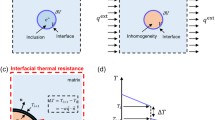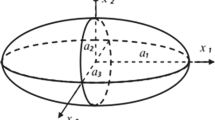Abstract
We consider the electric, thermal and elastic fields in an infinite conductor or semiconductor plate containing an arbitrarily shaped inhomogeneity. Complex variable and numerical methods are used to discuss effective conductivities and the effect of electric current on the thermal stress distribution. Our results show that the effective electric and thermal conductivities depend strongly on the shape and size of the inhomogeneity. In addition, the electric current generates considerable thermal stress in the vicinity of the inhomogeneity allowing for the possibility of enhancing or neutralizing any thermal stress induced by heat flux. Detailed analyses indicate that the remote electric current suppresses the maximum normal stress while either suppressing or enhancing the maximum shear and hoop stresses around an arbitrarily shaped inhomogeneity depending on the material parameters and shape of the inhomogeneity. Our findings also allow us to conclude that the electric current suppresses maximum normal and shear stresses on the interface in the case of a triangular inhomogeneity, which, of course, dramatically reduces the threat of interface debonding which is known to be one of the main causes of failure in composites. This research provides a theoretical basis for the prediction of the effective performance as well as for the control of thermal stress in composites.







Similar content being viewed by others
References
Ajayan, P.M., Tour, J.M.: Materials science: nanotube composites. Nature 447(7148), 1066 (2007). https://doi.org/10.1038/4471066a
Brandt, J., Drechsler, K., Arendts, F.J.: Mechanical performance of composites based on various three-dimensional woven-fibre preforms. Compos. Sci. Technol. 56(3), 381–386 (1996). https://doi.org/10.1016/0266-3538(95)00135-2
Sanchez, F., Ince, C.: Microstructure and macroscopic properties of hybrid carbon nanofiber/silica fume cement composites. Compos. Sci. Technol. 69(7–8), 1310–1318 (2009). https://doi.org/10.1016/j.compscitech.2009.03.006
Liu, S., Shi, B., Siddique, A., Du, Y., Sun, B., Gu, B.: Numerical analyses on thermal stress distribution induced from impact compression in 3D carbon fiber/epoxy braided composite materials. J. Therm. Stress. 41(7), 903–919 (2018). https://doi.org/10.1080/01495739.2018.1437000
Wu, L.: Bounds on the effective thermal conductivity of composites with imperfect interface. Int. J. Eng. Sci. 48(9), 783–794 (2010). https://doi.org/10.1016/j.ijengsci.2010.04.005
Rabinovitch, O.: Impact of thermal loads on interfacial debonding in FRP strengthened beams. Int. J. Solids Struct. 47(24), 3234–3244 (2010). https://doi.org/10.1016/j.ijsolstr.2010.08.003
Murakami, G.: A stress singularity parameter approach for evaluating the interfacial reliability of plastic encapsulated LSI devices. J. Electron. Packag. 111, 243 (1989). https://doi.org/10.1115/1.3226542
Hasebe, N., Bucher, C., Heuer, R.: Analyses of thermal conduction and stress induced by electric current in an infinite thin plate with an elliptical hole. J. Therm. Stress. 32(10), 1065–1086 (2009). https://doi.org/10.1080/01495730903103143
Song, K., Song, H.P., Schiavone, P., Gao, C.F.: Thermal stress induced by electric current in the vicinity of an elliptic inclusion in an infinite plate. J. Therm. Stress. 42(8), 976–992 (2019). https://doi.org/10.1080/01495739.2019.1607789
Song, H., Song, K., Gao, C.: Temperature and thermal stress around an elliptic functional defect in a thermoelectric material. Mech. Mater. 130, 58–64 (2019). https://doi.org/10.1016/j.mechmat.2019.01.008
Birman, V.: Control of fracture at the interface of dissimilar materials using randomly oriented inclusions and networks. Int. J. Eng. Sci. 130, 157–174 (2018). https://doi.org/10.1016/j.ijengsci.2018.05.011
Colombi, P., Bassetti, A., Nussbaumer, A.: Analysis of cracked steel members reinforced by pre-stress composite patch. Fatigue Fract. Eng. Mater. Struct. 26(1), 59–66 (2003). https://doi.org/10.1046/j.1460-2695.2003.00598.x
Song, K., Song, H.P., Schiavone, P., Gao, C.F.: Electric current induced thermal stress around a bi-material interface crack. Eng. Fract. Mech. 208, 1–12 (2019). https://doi.org/10.1016/j.engfracmech.2019.01.004
Todoroki, A.: Electric current analysis of CFRP using perfect fluid potential flow. Trans. Jpn. Soc. Aeronaut. Space Sci. 55(3), 183–190 (2012). https://doi.org/10.2322/tjsass.55.183
Song, H.P., Gao, C.F., Li, J.: Two-dimensional problem of a crack in thermoelectric materials. J. Therm. Stress. 38(3), 325–337 (2015). https://doi.org/10.1080/01495739.2015.1015369
Parkus, H.: Thermoelastisity. Blaisdell Publishing Company, Waltham (1968)
Muskhelishvili, N.I.: Some Basic problems of Mathematical Theory of Elasticity. Noordhoff, Leyden (1975)
Wang, P., Wang, B.L.: Thermoelectric fields and associated thermal stresses for an inclined elliptic hole in thermoelectric materials. Int. J. Eng. Sci. 119, 93–108 (2017). https://doi.org/10.1016/j.ijengsci.2017.06.018
Song, K., Song, H.P., Gao, C.F.: Unavoidable electric current caused by inhomogeneities and its influence on measured material parameters of thermoelectric materials. J. Appl. Phys. 123(12), 124105 (2018). https://doi.org/10.1063/1.5011778
Song, K., Song, H.P., Schiavone, P., Gao, C.F.: Thermal stress around an elliptic hole weakened by electric current in an infinite thermoelectric plate. J. Mech. Mater. Struct. 14(1), 179–191 (2019). https://doi.org/10.2140/jomms.2019.14.179
Song, K., Song, H.P., Li, M., Schiavone, P., Gao, C.F.: Effective properties of a thermoelectric composite containing an elliptic inhomogeneity. Int. J. Heat Mass Transf. 135, 1319–1326 (2019). https://doi.org/10.1016/j.ijheatmasstransfer.2019.02.088
Wang, S., Dai, M., Ru, C.Q., Gao, C.F.: Stress field around an arbitrarily shaped nanosized hole with surface tension. Acta Mech. 225(12), 3453–3462 (2014). https://doi.org/10.1007/s00707-014-1148-7
Li, H., Wang, L., He, Y., Hu, Y., Zhu, J., Jiang, B.: Experimental investigation of thermal conductivity and viscosity of ethylene glycol based ZnO nanofluids. Appl. Therm. Eng. 88, 363–368 (2015). https://doi.org/10.1016/j.applthermaleng.2014.10.071
Lu, H., Liu, Y., Huang, W.M., Wang, C., Hui, D., Fu, Y.Q.: Controlled evolution of surface patterns for ZnO coated on stretched PMMA upon thermal and solvent treatments. Compos. Part B Eng. 132, 1–9 (2018). https://doi.org/10.1016/j.compositesb.2017.08.009
Dunstan, D.J.: The size effect in the mechanical strength of semiconductors and metals: strain relaxation by dislocation-mediated plastic deformation. J. Mater. Res. 32(21), 4041–4053 (2017). https://doi.org/10.1557/jmr.2017.300
Acknowledgements
K. Song appreciates the support of the China Scholarship Council. H. P. Song and C. F. Gao acknowledge the support of the National Natural Science Foundation of China (Grant Nos. 11872203 and 11202099), the Priority Academic Program Development of Jiangsu Higher Education Institutions (PAPD). Schiavone thanks the Natural Sciences and Engineering Research Council of Canada for their support through a Discovery Grant (Grant # RGPIN 155112).
Author information
Authors and Affiliations
Corresponding authors
Additional information
Publisher's Note
Springer Nature remains neutral with regard to jurisdictional claims in published maps and institutional affiliations.
Rights and permissions
About this article
Cite this article
Song, K., Song, H.P., Schiavone, P. et al. Effective conductivity and the effect of electric current on thermal stress around an arbitrarily shaped inhomogeneity. Arch Appl Mech 89, 2449–2461 (2019). https://doi.org/10.1007/s00419-019-01588-z
Received:
Accepted:
Published:
Issue Date:
DOI: https://doi.org/10.1007/s00419-019-01588-z




